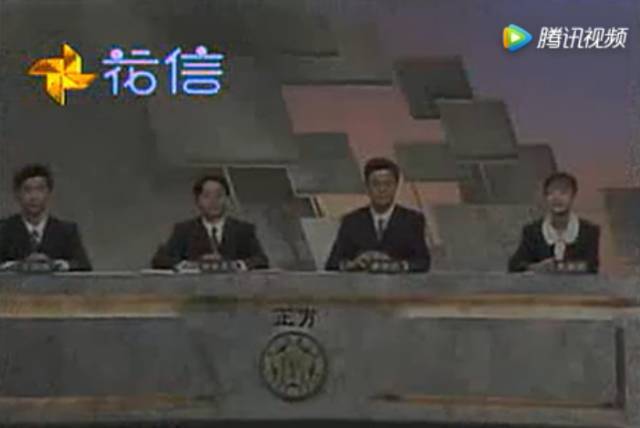史上最强辩论赛,王沪宁金墉李显龙悉数登场,我们的青葱岁月! 李欢龙 2023-05-07 于浙江杭州市富阳区疾控中心主任医师 历经千辛万苦 终于找到1993年国际大专辩论赛视频+文字实录 https://www.youtube.com/watch?v=V1SWh0ZzvSE 时间:1993年8月29日下午 地点:新加坡 辩题:人性本善 正方:台湾大学队 
从右至左依次是吴淑燕(一辩),蔡仲达(二辩),许金龙(三辩),王信国(四辩) 反方:复旦大学队 

评委: 




辩论赛主宾: 
▲时年41岁的新加坡副总理、李显龙准将 主席:黎学平 
以下是决赛实录(视频+文字)(1993年国际大专辩论赛视频,时长53分钟) 主席:观众朋友,欢迎光临1993年国际大专辩论会大决赛。 这个国际大专辩论会是由新加坡广播电视局和中国中央电视台联合举办的。过去的一个星期,辩论会的八支队伍经过四场初赛,二场半决赛之后,其中的六支队伍淘汰了。今天进入大决赛的两支队伍可说是辩论经验丰富的精英,他们肯定会在今天的比赛中大展辩才,给大家带来场“劲”的(比赛),让大家大饱耳福。今天我们非常荣幸地邀请到新加坡副总理李显龙准将出席我们的大决赛(掌声)。国际大专辩论会的冠军队将获得一万元的现金奖,亚军队可获得五千元。另外,我们也将在过去几场和今天的辩论群英会中选出一位最佳辩论员,他可以获得二千元的现金奖励。现在向您介绍参加今天大决赛的两支队伍,台湾大学和复旦大学。在我右手边的是正方台湾大学的代表,第一位是吴淑燕,政治系二年级;第二位是蔡仲达,会计系二年级;第三位是许金龙,政治系二年级;第四位是王信国,哲学系二年级(掌声)。在我左手边的是反方复旦大学的代表:第一位是姜丰,中文系中国语言文学研究生二年级;第二位是季翔,法律系二年级;第三位是严嘉,法律系四年级;第四位是蒋昌建,国际政治系硕士班三年级(掌声)。 今天我们的评判团阵容也特别强大。五人评判团是由本地和海外专业人士组成的。他们是:郭振羽教授,他是南洋理工大学传播学院院长(掌声);第二位是吴德耀教授,他是前东亚哲学研究所所长(掌声);第三位是查良镛先生,是著名武侠小说家,笔名金庸(掌声);第四位是杜维明教授,他是美国哈佛大学东方语言及文明学系教授(掌声);第五位是许廷芳律师,他是新加坡广播局董事(掌声)。 今晚的辩题是人性本善,反方的立场是人性本恶。双方的立场是由抽签决定的。现在我宣布1993年国际大专辩论会大决赛正式开始。首先将由正方一辩吴淑燕同学表明立场和发言,时间为三分钟(掌声)。 吴淑燕:大家好!哲学家康德主张,人不分聪明才智、贫富美丑都具有理性。孟子认为人性本善,所以进一步又加了一句,每个人都有恻隐之心。而佛家说,一心迷是真身,一心觉则是佛。正因为人性本善,所以人随时随地都可以放下屠刀、立地成佛。我方主张人性本善,就是主张人性的根源点是善的,有善端才会有善行。我方不否认在人类社会中存在有恶行,但是恶行的产生则是由外在环境所造成,所以恶是结果而不是原因。如果硬要说恶是因不是果,也就是说人性本恶,那么人世间根本不能产生真正的道德。虽然英国哲学家霍布斯极力主张在人性本恶的前提下人类可以形成道德。但是想想看,如果人性本恶,人类一切道德规范都是作为人类最大的利己手段。当道德成为手段时,道德还是道德吗?也就是说,人一旦违犯道德而不会受到处罚,人就不会遵守道德的约束了。深夜两点我走在道路上看到红灯,如果人性本恶我就会闯过去,因为不过是为了个人方便。但事实上并不是如此,仍然有许多人遵守交通规则。而根据人性本恶的前提假设,霍布斯认为必须有一个绝对的、无所不在的权威监督每个人履行道德规约。如果人性本恶,没有一个人会心甘情愿地遵守道德规约,但是事实证明:人还是有善行、人还是有道德、还是有利他的行为。如果人性本恶,(时间警示)那么我们只有两种选择:第一个是活在一个“老大哥”无时不刻不监督我们的世界当中;第二个是我们人类社会将是彼此不再相信。如果这样的话,我就会看到一个老太太跌倒了有人把她扶起来,人们则说他居心不良;而我们在辩论会中建立起来的友谊都是虚假的装腔作势。但是我们会发现,在人类历史社会当中,没有一个绝对权威的君主曾经产生过,但是舍己为人的事情在不断地发生。而在生活当中,为善不为人知的生徒小民更是比比皆是。 泰丽莎修女的善行,大乘佛教中所说的“众生永远不得渡,则已终身不作佛”的慈悲宏愿,难道不正是人性本善的最佳引证吗?(时间到)谢谢!(掌声)。 主席:谢谢吴淑燕同学,接下来请反方第一位代表姜丰同学表明立场和发言,时间也是三分钟。(掌声)。 姜丰:谢谢主席,大家好!我先要指出一点的是,康德并不是一个性善论者。康德也说过这样一句话:“恶折磨我们的人,时而是因为人的本性,时而是因为人的残忍的自私性。”对方不要断章取义。另外对方所讲到的种种善行,那完全是后天的,又怎么能够说明我们命题当中的“本”呢?神话归神话,现实归现实。对方同学请你们摘下玫瑰色的眼镜看看这个现实的世界,就在你陈辞的这三分钟当中,这个世界又发生了多少战争、暴力、抢劫、强奸。如果人性真是善的话,那么这些罪恶行为到底从何而来呢?对方为什么在他们的陈辞当中,自始至终对这个问题避而不答呢?我方立场是:人性本恶。 第一,人性是由社会属性和自然属性组成的,自然属性指的就是无节制的本能和欲望,这是人的天性,是与生俱来的;而社会属性则是通过社会生活、社会教化所获得的,它是后天属性。我们说人性本恶当然指的是人性本来的、先天的就是恶的。 第二,提到善恶,正如一千个观点会有一千个“哈姆雷特”,一千个人心目当中也许会有一千个善恶标准。但是,归根到底恶指的就是本能和欲望的无节制地扩张,而善则是对本能的合理节制。我们说人性本恶正是基于人的自然倾向的无限扩张的趋势。那个曹操不是说过:“宁可我负天下人,不可天下人负我”吗?那个路易十五不是也说过:“在我死后哪怕洪水滔天”。还有一个英国男孩,他为了得到一辆自行车竟然卖掉自己三岁的妹妹。这些对方还能说人性本善吗? 第三,虽然人性本恶,但是我们这个世界并没有在人欲横流中毁灭掉,这是因为人有理性(时间警示)。人性可以通过后天教化加以改造。当人的自然倾向无限向外扩张的时候,如果社会属性按照同一方面推波助澜,那么人性就会更加堕落;相反,如果我们整个社会倡导扬善避恶,那么人性就有可能向善的方向发展,这一点也不正说明了儒家思想所倡导的修齐、治平、内圣、外王是何等重要吗!对方辩友,如果真的是人性本善的话,那么孔老夫子何必还诲人不倦呢? 今天,对方辩友所犯的错误就在于以理想代替现实,以价值评判代替了事实评判。从感情上讲我们同所有善良的人一样也是希望人性是善的。但是历史、现实和理性都告诉我们,人性是恶的!这是一个事实,我们只有正视这个事实,才有可能扬善避恶。(时间到)。谢谢各位!(掌声) 主席:谢谢姜丰同学,接下来我们听听正方第二位代表蔡仲达同学的发言,时间三分钟。(掌声) 蔡仲达:大家好!刚才对方同学谈得很多,我们就一一来检视到底善是本还是恶是本?到底善是表象还是恶是表象?我们先举一个例子来说吧。如果我们今天要吃西瓜,是不是先要种西瓜种子呢?如果我们种红豆、绿豆,长得出西瓜吗!所以人世间为什么这么多善行呢,当然是在人的本性中就有着善的种子嘛。 那人世中为什么有恶的表象呢?很简单嘛,我们都知道我们种西瓜只要丢西瓜种子就好了吗?我们还要施肥,还要浇水啊,而且一不小心,万一再下了十几天的大雨,那么西瓜不仅长不好,而且还会烂掉。所以同样的嘛,我们在人类充满污染的环境中,我们承认有些人他虽然有善根,但是呢他长不出善果。他是长得不好,但是这并不是说他的人性中没有善的种子啊!所以我们发现很多犯罪人到最后他们都良心发现。我们说他是良心未泯,那么想想看,如果人的良心自始就不存在于人的本性中的话,那么我们怎样去解释人有后悔的行为呢?大家不都曾经后悔过吗? 好的,对方同学又指出了另外一点,说人的恶是因为人有欲望,人有这样的本质,那我就不懂了,为什么欲望一定带来恶呢?我今天喜欢一个女生,这个女生也喜欢我,我们都想跟对方结婚,我们组成美好家庭,这是恶吗?(笑声、掌声)再说吧,人有本能,人肚子饿了就想吃饭,那人跟狮子不就是一样了吗?对方同学您如何解释呢?另外我们再想一想吧,对方同学说人的本性可以教育,所以恶的本性可以教育成善,我们就来想一想,为什么人的本性可以被教育成善呢?我们说小鸟会飞,它只要学了飞就可以飞,为什么我们人怎么教,我们都不会自己飞呢?因为我们本性中没有飞的本性嘛,(时间警示)那么人为什么被教成行善呢?就是因为我们相信人的本性中有善性嘛。如果说人的本性是恶的而能够教成善的,那我们就觉得很奇怪了。如果人的本性没有善性为什么我们一学就知道什么是善,一教就知道怎么行善,而教怎么飞再怎么教你都不会呢?就算如果本性是恶,那到底谁来教我们,是本恶的人来教我们本恶的人吗?他们为什么要教我们呢?他们到底有什么动机,我们能够信任他吗?他们教育我们行善,孔夫子要教育我们行善,他们背后是不是有一个更大的恶的动机呢?(笑声、掌声)我们觉得很奇怪,对不对?比如说吧,一个老人跌倒了,我们把他扶起来;我们来新加坡,交这么多朋友,以辩会友,我们情意真挚;我们看到非洲饥民,人人心中都有孤拯、悲哀、悯天地不悯的心情,如果说扶老人就是沽名钓誉;交朋友这是虚伪矫情……(时间到)谢谢!(掌声) 主席:谢谢蔡仲达同学。接下来我们听听反方第二位代表季翔同学怎么反驳,时间三分钟(掌声)。 季翔:谢谢主席,各位好!对方辩友我倒真想请问你这样一个问题,既然社会是由人构成的,对方却认为社会环境中的恶和人之恶没有关系,那请问:外界环境中的恶是从哪里来的呢?你的善又是怎样导出恶的呢?我方从来不认为本能和欲望就是恶,本能和欲望的无节制地扩展才是恶(掌声)。对方辩友,孔子早就告诉过我们:“道听途说,德之弃也。”我方认为,人性本恶主要基于如下理由。 第一,人性本恶是古往今来人类理性认识的结晶。早在两千年前,所谓人类文明的轴心时代,荀子的性恶论与犹太教的原罪说便遥相呼应。而到近代,从马基雅维里到弗洛伊德,无一不主张人性本恶,这难道仅是历史的巧合吗?不!伟大的哲学家黑格尔一语道破天机,“人们以为当他们说人性本善时是说出了一种伟大的思想,但他们忘记了。当他们说人性本恶时,他们是说出了一种伟大的多的思想。”(掌声)令人遗憾的是,对方辩友面对这样的真知灼见,至今未能幡然醒悟,这不由得使我想起乔西·比林斯的那句话,“真理尽管稀少,却总是供过于求。”(掌声) 第二,人性本恶是日常生活一再向我们显示的道理。从李尔王的不孝女儿们到《联合早报》上拳击妻子脸部的丈夫们,从倒卖血浆的联合国维和部队到杀人不眨眼的拉美毒枭,恶人恶事真可谓横贯古今,不胜枚举。对方辩友,难道你还要对着《天龙八部》中恶贯满盈、无恶不做、凶神恶煞、穷凶极恶这四大恶人谈什么人性本善吗?(掌声、笑声) 第三,尽管我们承认人性本恶,(时间警示)但并不意味着人类前途一片黑暗,人之所以成为宇宙之精华、万物之灵长,并不因为他白壁无瑕,完美无缺,而在于能有认识自己的勇气,承认人性本恶;人有判断是非的理性,能够扬善弃恶。为了矫治本恶的人性,人们不仅制定法律以平息暴力、规范道德以减少争斗、设立政府以处罚叛逆,而且倡导坚贞以反对意乱行迷、编写童话去诅咒忘恩负义(掌声)。真可谓苦心孤诣、殚精竭虑。而对方辩友却坚持人性本善,言下之意人类所有的道德教化都是多此一举了!心痛之余我不禁请问对方辩友,如果人性本善,那么我们要道德法律、交通规则干什么呢?如果人性本善的话,个人修养、社会教化还有存在的必要吗?(时间到)谢谢!(长时间掌声) 主席:谢谢季翔同学,接下来我们请正方第三位代表许金龙同学发言,时间三分钟。(掌声) 许金龙:孔老夫子孜孜不倦,因为他是个勤于灌溉善根的人。对方辩友,大家好!我想请问对方辩友,今天提出了这么多,如果说人性真的是本恶的,我们来请问下面几个问题:如果说呀,驯兽师可以改变狮子的本性的话,那么我们想想看,我们可以教狮子敬礼,也可以教狮子行善吗?我再想请问对方辩友,如果说今天是人性本恶的话,对方辩友说的种种教育,那可能实行吗?谁会信任谁,由哪一个性善的人来教,还是性恶的人来教呢?如果说性恶的人来教的话,那谁会服谁呢?他教的凭什么就是善的呢?今天对方辩友最根本的关键的矛盾错误就在于说,他相信人性本恶,但本恶的人会摒弃恶的价值吗?本恶的人会喜欢恶吧,他讨厌的是什么呢?讨厌的是某一个人加在他身上的恶行。所以说,本恶的人应当是非常快乐地去行恶才对,他最讨厌、难过的是别人的恶加在他身上才对。所以说,今天对方辩友在这样的错误矛盾之下,怎么能告诉我们说,人性本恶的,但人又会摒弃恶的价值呢?既然人性本恶,人就会欢欢喜喜地接受恶的价值。接下来我们再来看对方辩友今天说的什么?对方辩友,今天说啊,人性有两层,一种是自然属性,是天性,再一种是社会属性,那种是后天的。自然属性就是说人的天性就跟动物一样,有欲望的本能。对了,对方辩友说得好,自然属性,人就只有自然属性,本能的欲望而已吗?那人跟动物有什么差别呢?跟狮子老虎又有什么差别呢?对方辩友,请您待会儿要解释给大家听。(笑声)那么再说到人的社会属性,我就不懂了,人的社会属性,为什么就是后天的,不是本性?人的社会属性就是说人可以被教,人有善根,人有善端,那这不就是人的本性了?对方辩友,如果说今天本性可以移来移去,从恶换到善,从善换到恶,那我想请问,本来的性到底是什么?(鼓掌)如果对方辩友说今天坚信,历史演进过程当中都是往恶的方向移动的话,我方今天没有话说。今天就在于说,整个历史过程都是往善的去移动,所以我们相信,对方辩友也相信,该往善的方向去移动,可是谁会相信,社会该往善的方向去移动呢?是那些本恶的人吗?如果说对方辩友真的坚信本恶的话,那我就要称赞对方辩友一句:你是泯灭天性,没有天良的人了!(笑声、掌声)因为那就是您顺性而为,顺乎自然,应乎天理,顺乎人心了吗?所以,我们再来想想看,如果说我们建立起来一个本恶的世界的话,我们的社会会是怎么样?相信我,我们在这里谈,不是谈输赢,是谈真理。如果说人性本恶,我们彼此无法信任。你坐在那里,我坐在这里,我们彼此有什么样的语言可以进行沟通。因为你会怀疑我,我会猜忌你,如果没有本,如果没有善良的端行,没有善良种子,我们怎么在这里进行流畅的沟通呢?在这里,我方要一再地强调的是说,今天对方辩友,如果今天(时间到)相信人性本恶的话,就不会有我们这群和善的人群了。(掌声) 主席:接下来我们听听反方第三位代表严嘉同学怎么反驳,时间三分钟。(掌声) 严嘉:谢谢主席,各位好!对方一辩说,有的人是“放下屠刀,立地成佛”的,这不错,但我请问,如果人都是本善的话,谁会拿起屠刀呢?(掌声)第二,对方二辩说,人一教一学就能够会善,那我们看到好多人他们做恶事的时候,是不要教,不要学,就会去做的。(笑声、掌声)我们再看到,对方辩友认为恶都是外因,但我请问,如果鸡蛋没有缝的话,苍蝇会去叮它吗?所以,还是它有内因在起作用的。至于说到,善端是从哪儿来的?我告诉对方辩友,如果人人皆自私的话,那么人人都不能自私。因此制约、权衡中产生节制,这就是最早的善源。至于后天的教化,它自然而然形成了。对方辩友不要对历史事实视而不见。好,下面我从现实和历史的层面进一步阐述我方观点。 第一,人类在诞生之初,就已经把本恶的人性充分地显示出来。人类学研究表明,周口店猿人就已经懂得用火来把同类的头骨烤着吃,这种生猛烧烤,是何等凶残啊!而《人类的起源》一书中告诉我们,当一个土人的小孩不小心,把一筐海胆掉进海里的时候,土人竟把他活活地摔死在石崖上。面对着原始人这种凶残的天性,对方辩友,难道还告诉我们,人性本善吗? 第二,正是由于人性本恶的存在,所以,在人类社会沧海桑田的演进过程之中,教化才显得尤其重要,而且也相当艰巨。“十年树木,百年树人”,我方从来不否认,通过后天的教化和修养,人是可以对他的人性加以改变,甚至形成伟大的人格的。但是,正因为有本恶的人性存在,所以,我们要知道,学好三年,学坏三天,(时间警示)“病来如山倒,病去如抽丝”呀。请大家想一想,看暴力片,色情片,是从来没有什么公开的倡导和鼓励的,但为什么总有那么多人要趋之若鹜呢?(笑声、掌声) 第三,认识到人性本恶,其实并不是人类的羞耻。真正应该反省的,是面对着真理,却不敢去正视它。其实,人类社会演进的过程,从某种意义上也就是人的尊严这种虚假的虚荣被不断剥去的过程。我们看到在神学灵光笼罩之下,人类曾经是相当的夜郎自大。但是,哥白尼的日心说,抹去了人在宇宙中的中心地位;达尔文的进化论揭示人与动物之间必然的内在联系;而弗洛伊德则披露了在理性的冰山尖之下,人的巨大的本能的冲动与欲望。今天,我们也只有真正地认识到人性本恶这一基础,(时间到)才能做到抑恶扬善。谢谢!(掌声) 主席:谢谢严嘉同学,听过双方代表对善恶的陈辞。现在是他们大展辩才的时候。在自由辩论开始之前先提醒双方代表,你们每队各有四分钟发言时间,正方同学必须先发言。好,现在自由辩论开始!(掌声)王信国:我想首先请问对方辩友,既然人性本恶,世界上为什么会有善行的发生? 蒋昌建:我方一辩已经解释了。我倒想请问对方辩友,在评选模范丈夫时,你能告诉我,这个模范丈夫本性是好的,就是经不起美色的诱惑吧?(笑声、掌声) 许金龙:对方辩友,他要有人勤加于灌溉,我想请问对方辩友,请您正面回答我,您喜不喜欢杀人放火?(笑声) 季翔:我当然不喜欢,因为我受过了教化。但我并不以我的人性本恶为耻辱。我想请问对方,你们的善花是如何结出恶果的?(掌声) 吴淑燕:我想先请问对方同学,您的教育能够使你一辈子不流露本性吗?如果您不小心流露本性,那我们大家可要遭殃了。 严嘉:所以我要不断地注意修身自己呀!曾子为什么说:“吾日三省吾身”呢?所以,我再次想请问对方辩友,你们说内因没有的话,那恶花为什么会从善果里产生呢? 王信国:我来告诉大家为什么会有,这是因为教育跟环境的影响吗!我倒请对方辩友直接回答我们问题嘛,到底人世间为什么会有善行的发生,请你告诉大家。 姜丰:我方明明回答过了,为什么对方辩友就是对此听而不闻呢?到底是没听见,还是没听懂啊?(笑声、掌声) 许金龙:你有本事再说一遍,为什么我们听了,从来没有听懂过呢?我想请问对方辩友,您说荀子说性恶,但是所有的学者都知道荀子是无善无恶说。 蒋昌建:我第三次请问对方辩友,善花如何开出恶果呢?第一个所谓恶的老师从哪来呢? 吴淑燕:我倒想请问对方同学了,如果人性本恶,是谁第一个教导人性要本善的?这第一个到底为什么会自我觉醒? 季翔:我方三辩早就解释过了,我想第四次请问对方辩友,善花是如何结出恶果的? 王信国:我再说一次,善花为什么结出恶果,有善端,但是因为后天的环境跟教育的影响,使他作出恶行。对方辩友应该听清楚了吧?我再想请问对方辩友,今天泰丽莎修女的行为,世界上盛行好的行为,为什么她会做出善行呢? 季翔:如果恶都是由外部环境造成的,那外部环境中的恶又是从何而来的呢? 蔡仲达:对方辩友,请你们不要回避问题,台湾的正严法师救济安徽的大水,按你们的推论不就是泯灭人性吗? 严嘉:但是对方要注意到,8月28号《联合早报》也告诉我们这两天新加坡游客要当心,因为台湾出现了千面迷魂这种大盗。(笑声、掌声) 许金龙:我们就很担心人性本恶如果成立的话,那样不过是顺性而为,有什么需要惩罚的呢? 蒋昌建:对方终于模糊了,我倒想请问,你们开来开去善花如何开出恶果,第五次了啊!(笑声、掌声) 吴淑燕:我方已经说过了,是因为外在环境的限制,我倒想请问对方同学了,对方同学告诉我们,人有欲望就是本恶,那么对方同学想不想赢这场比赛呢?如果想的话,您可真是恶啊(笑声、掌声) 姜丰:对方辩友口口声声说,因为没有善端就没有善。我们要问的是,都是善的话,那第一个恶人从哪里来?又哪里有你们所说的那种环境呢? 许金龙:环境天险,天险狡恶。对方辩友,您没有听说过吗?环境会让人去行恶的。 严嘉:对方似乎认为有了外部恶的环境,人就会变恶。请问在南极,在一种非常艰难的沙漠之中,人就会变坏了吗? 王信国:我方没有这样说,对方又在第二次栽赃,我是要告诉大家,是说人有善端,你在哪个环境,好的环境会变好,坏的环境会变坏。 季翔:如果都如对方所说的那样,人性本善,都是阳光普照,雨水充足,那还要培育它干什么呢?让它自生自灭好了。(笑声、掌声) 许金龙:照对方辩友那样说的话,人性本恶,我们要教育干什么?因为“师傅领进门,修行在个人”,这句话早就不成立,应该是“师傅领进门,教鞭跟你一辈子。”(笑声、掌声) 严嘉:按照对方辩友的这种逻辑,那么教化应该是非常容易的,每个人都是“心有灵犀不点通”了?(笑声、掌声) 王信国:我倒想请问对方辩友,在人性本恶之下,我们为什么要法律,为什么要惩治的制度呢? 姜丰:对呀,这不正好论证了我方观点嘛!(笑声、掌声)如果人性都是善的还要法律和规范干什么?(掌声) 蔡仲达:犯错、犯罪都是人性本恶,就符合您本恶的立场了吗?那么犯罪干嘛要处罚他呢? 蒋昌建:我还没听清楚,你们论述人性是本善的,是在进化论原始社会的本,还是人一生下来的本,请回答! 许金龙:我方早就说过的嘛!孟子说良心啊,你有没有恻隐之心,你有没有不安不忍之心,这就是良心嘛!你怎么不听清楚了呢?(笑声、掌声) 蒋昌建:如果人生来就是善的话,那我想那个“宝贝”纸尿布怎么那么畅销啊?(笑声、掌声) 吴淑燕:我想请问对方同学,再次请问你,如果人性本恶的话,到底是谁第一个去教导人要行善的呢? 季翔:我方已经不想再次回答同样一个问题了!我倒想请问孟子不也说过“形色,天性也”嘛?请问什么叫天性呀? 许金龙:您讲得吞吞吐吐,我实在听不懂。对方辩友,请您回答我们荀子说的是性恶说,还是性无善无恶。 严嘉:这点都搞不清楚,还来辩论性善性恶?(笑声、掌声)我想请问,孔子说:“七十而从心所欲,不逾矩”像这样的圣人都要修炼到古稀之年,何况我们凡夫俗子呢?(掌声) 王信国:对方辩友,所有的问题,所有的问题都不告诉我们答案。我倒想请问对方辩友的是,康德的主张到底是有没有道德? 姜丰:不是我们不告诉对方,是我们一再一再地告诉,你们都不懂。(笑声、掌声) 许金龙:对方辩友这句话回答的什么,我们实在没有听出来。不过我想告诉对方辩友解决一下性恶的问题吧!荀子说:“无为则性不能自美”。说性像泥巴一样,它塑成砖就塑成砖,塑成房子就塑成房子,这是无恶无善说啊!对方辩友。 蒋昌建:荀子也说:后天的所谓善是在“注错习之所积耳”,什么叫“注错习之所积耳”呀?请回答。 许金龙:荀子说错了!荀子说他看到什么是恶的,还是说没有看到善,你就说是恶的。没有看到善是不善,不是恶,对方辩友。 蒋昌建:你说荀子说错了就说错了吗?那要那么多儒学家干什么?(笑声、掌声) 许金龙:儒学就是来研究荀子到底是说了性恶还是性善嘛! 季翔:荀子明明白白地告诉我们:“人性恶,其善者伪也。”(掌声) 蔡仲达:对方同学,如果说,荀子说恶就是恶的话,那我们今天还要辩什么呢? 严嘉:对方辩友不要一再地引语录了,我们看看事实吧!历史上那么多林林总总的真龙天子们,他们有几个不是后宫嫔妃三千,但为什么自己消费不了,却还要囤积居奇,到最后暴殄天物呢?(笑声、掌声) 王信国:那也想请对方辩友看看历史上展示的仁人志士的善行,对方辩友如何来解释呢? 姜丰:没有规矩不成方圆,到底何为善?何为恶? 吴淑燕:要谈现实,就来谈现实吧!如果人性本恶,我和对方同学定立契约,对方可千万不能相信哪,因为我可能会占你便宜呀!(笑声) 蒋昌建:对方说,有人的话那就是人性善的,拳击场上没有恻隐之心,没有慈让之心,那些观众,那些拳击者就不是人了?请回答。 许金龙:拳击场上是比竞技,有竞赛规则,又不是拿刀子来互相砍杀,对方辩友。(笑声)我们看看伊索比亚的难民,谁不会掉泪,谁不会动心忍性呢? 季翔:那当然会动心忍性了,因为人都受过教化了嘛。 许金龙:对方辩友,如果人都受过教化的话,但本在哪里呢?本为什么移来移去,可以从善变到恶,从恶变到善,本在哪里? 严嘉:佛祖释伽牟尼可算是至德至善之人了吧,但他在释伽族作王子的时候,不也曾六根不清静过吗? 王信国:所以他最后变好了,为什么?因为他的本心,他的根源是善的。(掌声) 姜丰:如果我们光说本的话,我们只要说人性恶就行了,你们论证本了吗? 许金龙:我们当然论证本了,良心就是本哪!对方辩友,您才没有论证本呢!您说的那是跟动物一样啊!(掌声) 蒋昌建:那我就不知道了,哪个人过马路的时候,是捧着这个良心过去的吗?我倒听说过孤胆英雄,却没有听说过“孤心英雄”啊(笑声、掌声) 许金龙:人过马路当然是捧着良心过去的。而且,看到老弱病残的时候,我们还要扶他一下。对方辩友,人是带着良心过去的。 严嘉:为什么我们要进行交通法则教育呢?这不是后天让他向善吗? 王信国:因为有人要变坏,所以要纠正他,纠正他是因为他会变好。 季翔:对方始终没有告诉我们,既然人性都是本善的,怎么会有人变坏呢? 吴淑燕:请对方同学正面回答如何利用教育来把人性恶改过去? 姜丰:我方早已回答,倒是请对方正面回答,按照种瓜得瓜的逻辑……(时间到) 主席:对不起…… 许金龙:对方辩友,从来没有回答过问题,就说回答过。我们来看看对方辩友,对方辩友一辩说人是理性的动物,那么如果说这个社会上人有一个滞胀的,那人就不理性了。(掌声) 主席:经过了精彩激烈的自由辩论之后,我们的节目到这里暂时告一个段落,稍过后我们再见。 主席:欢迎各位回到辩论会现场,现在我们请反方第四位代表蒋昌建同学总结陈辞,时间四分钟。(掌声) 蒋昌建:谢谢各位,一个严肃的辩论场需要一个严肃的概念。对方多次问我们人性怎么样?人性怎么样?始终没有问我们人性本怎么样?我想请问对方,人性是什么和人性本是什么是同样的一个概念吗?你们如果连这个概念都没有根本建立基础的话,那你们的立论从何而来呢?我们多次问对方的善花里面如何结出恶果,对方说要浇水,要施肥呀。那我就不懂了,大家都承蒙这个阳光雨露的话,为何有那么多罪行横遍这个世界呢?难道这个水,那个肥还情有独钟吗?为何要跟恶的人作一个潇洒的“吻别”呢?(笑声、掌声) 今天我们本着对真理的追求来同对方一起探讨这个千年探讨不完的话题。无论是从性善论的孟子也好还是性恶论的荀子也好,又有哪一家哪一派不要我们抑恶扬善呢?抑恶扬善是我方今天确立立场的一个根本出发点。下面我再一次总结我方的观点。 第一,只有认识人性本恶,才能正视历史和现实。回顾历史的时候,我的内心总感到痛苦而颤抖。 从希波战争到十字军东征,从希特勒的奥斯维辛集中营到日寇在华北的细菌试验场,真可谓是“色情与贪婪齐飞,野心共暴力一色。”以往的人类历史,可以说是交织着满足人类无限贪欲而展开的狼烟与铁血啊!可见,本恶的人性如果不加以控制的话,将会给这个世界带来什么呢? 第二,只有认识人性本恶,才能重视道德、法律教化的作用,才能重视人类文明引导的结果,培养健全而又向上的人格。在历史的坎坷当中,人类并没有自取灭亡。尤其是在面对彬彬有礼、亲切友善的新加坡朋友面前,我们更有理由相信,人类明天会更好,这其中我们要感谢新加坡孜孜不倦地建立起他们优良的社会教化系统。人类文明是在人类智慧之光照耀下不断茁壮成长的。饮水思源,借此我们要感谢那些在人类教化路途中洒进他们含辛茹苦汗水的这些中西先哲们。正因为从他们的理论智慧当中,从他们的身体力行当中,人们才有可能从外在的强制走上理性的自约,自约人的本性的恶,从而培养一个健全而又向善的人格。可见,人性本恶,并不意味着人终身成为恶,只要通过社会的教化系统就可以弃恶扬善,化性起伪啊! 第三,只有认识人性本恶,才能调动一切社会教化的手段来扬善避恶。光阴荏苒,逝者如斯,在物质和科学技术突飞猛进的同时,而人类的精神家园可谓是花果飘零。在这个时候,我们要警惕,人性本恶这个基本的命题。可喜的是,在东方的大地上,我们说传统文化的发扬光大,已经从一阳来复开始走向了新的春天。我们也相信,通过传统文化的精华,必将使人类从无节制的欲望中合理地扼制并加以引导,从他律走向自律,从执法走向立法。人类才可能挽狂澜于既倒,扶大厦于将倾。“黑夜给了我黑色的眼睛,而我却要用它来寻找光明!”谢谢各位!(掌声) 主席:谢谢蒋昌建同学,最后我们请正方第四位代表王信国同学总结陈辞,时间也是四分钟。(掌声) 王信国:大家好!让我们先回到对方所建构的一个恶的世界来看看这个世界里边到底发生了什么事情。对方辩友告诉我们人性本恶,首先就犯了三大错误。第一大错误就是从经验事实的法则里面归纳出来的错误。对方辩友举出了人世间很多的恶事,告诉我们因此人性本恶,这是错的!为什么呢?对方辩友的立论告诉我们欲望,人是有欲望而来的。但是我们想,我方已经论证过了,欲望是有好有坏,今天我喜欢你,我想要跟你结婚,这是一个不好的欲望吗?所以最终我们知道了,今天对方辩友是看到人世间的恶行,某些恶行,然后告诉我们说人性本恶。那为什么对方辩友忽略了经验事实上面呈现的善行呢?人世间的很多善行,你一定听过了,有人跌在地上你把他扶起来,你在汽车上让座给老人,或者是,你定也听过无名氏的指教。这些难道不是人世间的善行吗?这是对方辩友犯的第一大错误。第二大错误,对方辩友犯的是倒果为因的错误。对方辩友借用一种经验事实的法则告诉我们说,我们有恶的果,所以导出来恶就是因。如果真的这样说的话,我们发现是什么呢?每一个人都是恶,尤其对方辩友口口声声告诉我们要教育,要道德教育,你如何去教育呢?每一个人都是恶,由此来定出真正的法律,而定出的法律就是善法吗?恶人定出来的是恶法。如果你定出了法律,如何去遵循,每一个人都恶,我为什么要信任你,好像大家在这个地方,我为什么要相信你呢?你可能在骗我,于是我们这里所有的人都戴上面具。大家互相欺骗,互相蒙蔽,这样的世界是对方辩友所建构出来的。他告诉我们由于有欲望就建构出来个恶的世界。对方辩友犯的第三个错误是什么呢?他告诉我们人性的性就是欲望,我们根本就晓得说,我方一开始就论证了,人性就是人的心。孟子告诉我们:“人有四端之心。”这是一个善的种子,我们从来没有否认过说,人世间没有恶行。你有善苗,不见得你就不会有恶行。为什么呢?我们发现了,因为外在环境,因为资源缺乏,所以我们人在无形之中会做出一些恶的行为来伤害别人,这是不得已的。所以,我们教育跟法律就在于纠正人的行为。如果按照对方辩友告诉我们是恶行的话,你为什么去纠正它?人性本恶,人纠正的结果还是回到本。我们的人是性本善,因为我们知道每一个人都有一颗向善的心,于是你透过道德,透过教育,透过法律,他有可能会转变为好。教育跟法律的功能就是要辅导,辅导他走上善途,于是乎,教育就在这个地方茁壮了。对方辩友举了个例子告诉我们说,原始人如何地烧杀虏掠,原始人如何地生灵涂炭。我们告诉大家的是,原始人民,他一开始那个求生的欲望,这跟本性是要区分的。因为当你如果说有五个人同时是饥饿的状态下,有一块面包在那边,一个人跑过去吃,这个时候绝对不会有人用道德来非难他。因为这个时候生存是立于道德之上的。你没有个人的生命,你没有生存的欲望,你如何来谈道德呢?所以原始人那个状况是一种动物性的本能。(掌声)所以,开始对方辩友犯的错误就是告诉我们说,人性是欲望,如果真的是欲望的话,人跟动物怎么分呢?人之异于禽兽者,已心就是一个本心的问题。所以我们说过人有善苗。今天对方辩友告诉我们说都是阳光雨露,没有错!但是有风吹雨打,因为你的风吹雨打,你的外在环境影响,你当然会做出恶的行为。所以,我们要纠正他,让他走向善的世界大同。所以,我们来看看世界上所有善行的发生吧!从历史上,从目前经验事实上面,我们发现,古往今来,志士仁人杀身成仁,等等之类。还有目前,泰丽莎修女等等之类,甚至说,大陆发生了安徽水荒,正严法师的慈济行为,对方辩友如何来解释呢?孟子就告诉我们了:“见孺子,掉落于井”,在这么一刹那之间你都会救他,你不可能把他推下去。为什么?人的本性是善的,你不要告诉我说,原来你救那个小孩子是为了虚名。原来你过马路遵守交通规则你是不得已的,你是虚假的。原来,泰丽莎修女救了你,那是一个骗人的行为。到最后,你会发现,只有浅水湾的鲨鱼才是一个大善人。(时间到)这是一个什么样的世界,这是一个恐怖的世界,这个世界之所以能够存在,就是因为我们有善根。谢谢!(掌声) 主席:谢谢王信国同学。在这一片善恶声中,人性到底是什么呢?还是让评判专家们去伤脑筋吧!接下来我们请评判团退席!我们稍后见。(休息、评判团评决) 主席:各位来宾,观众朋友,欢迎大家回到辩论会现场。在宣布成绩之前,先让我邀请评判团代表杜维明教授给我们分析今晚的赛情。杜教授请! 杜维明:主席,评判同仁,台大和复旦的辩论员,各位来宾。作为一个海外华人,并且是关切文化中国发展前景的学术工作者,我谨代表评判团向举办1993年国际华语大专辩论赛的新加坡广播局和中国中央电视台表示恭贺和感激。他们从世界各地,亚洲、澳大利亚、西欧和北美的著名大学邀请到八队三十多位口若悬河的青年才俊,在一周之间,针锋相对,辩论了大众传播、现代化、环保、经济、道德,乃至生老病死,种种既有宏观的全球视野,又有切身的现实意义的课题,充分体现了华语国际化的精神。 还值得提出的是,昨天休会,主办单位又通过轻松愉快的旅游,为参赛朋友们提供了交谈和沟通的机会,也让大家对这个在企业竞争上勇猛如狮,而在自然环境方面又艳丽如花的星洲留下了深刻的印象。对了,新加坡建国以来的第一位民选总统王鼎昌先生和今天特别前来颁奖的李显龙副总理都是华校出身的辩才无障的政治领导,给我们很大的鼓舞和勉励。(掌声) 过去六天,台湾大学成功地建构了“现代化不等于西方化”和“安乐死应该合法化”两个命题;复旦大学也说服了评判员,“温饱不是谈道德的必要条件”,“艾滋病是社会问题”。今天呢,从正反两方来辩论人性本善,究竟鹿死谁手哇?今天下午正反两队似乎都直接或间接地采取了在古文章法里的启承转合这种策略。正方一辩站在高屋建瓴的方式引述康德、孟子和佛教,建立了性善为本,恶行为果的基本理论,脱俗不凡,条理简洁。我好像已经被说服了。 但是,这个交通规则的比喻不甚恰当。反方一辩呢,有这个排山倒海之势,坚持“人性本恶,其外者伪也”的观点,分辨自然属性和社会属性,简洁明了,很有震撼力。而且,用词精炼,有条不紊。我好像又被她说服了。(笑声)正方二辩呢,承接了一辩论述,又以西瓜种子为例,很贴切。认为欲望本身不是恶,也有理趣,使观点作了进一步的深入展开,还作了一些实证的补充。反方二辩呢,妙语如珠,既承接了一辩的观点加以发挥又猛攻正方二辩的经验基础,并且旁征博引,荀子,犹太教,黑格尔,甚至《天龙八部》(笑声),使正方好像陷入了防御的态势。那么,正方三辩作了一个转折,很有新意,但是没有充分地发挥。反方三辩大有异军突起之势,从新的思维角度展示了一些观点,比如说“放下屠刀”,屠刀何来呀,也很恰当地引用了达尔文、弗洛伊德各方面的观点。在资料运用方面,大家都能引经据典,而且也可以说妙语如珠吧。那么,似反方的知识结构比较谨严,也比较全面。在语气方面,正方是严厉质问,恳切坦诚,有的时候情绪比较激动。(笑声)那么反方呢,有点排山倒海,义正辞严,有时候嘛,轻松活泼,而且引逗幽默。但是,用词显得有点华丽,也许可以向平实方面再努力。自由辩论期间,双方短兵相接,此起彼落,好像双方都从金庸先生武侠小说中学到了出奇制胜的新招。(笑声)我们觉得双方似乎是势均力敌,用了先发制人哪,连续发问哪,分而治之、乃至巧设陷阱哪,声东击西等各种策略。那么,反方四辩文字流畅,好像行云流水。在结论这方面可以说是缝隙不留,圆而不滑。正方四辩呢?很有理据,特别是举出原始人的凶残是为了求生欲望,也很有说服力。但是,我提到了情绪有点激动。 那么,一般说来,反方颇能显示一种流动的整体意识,整个队伍运用一种整体配合的作战方略,加强了一种整体的攻击力,保证了对重点攻击目标的一种优势。也增强了整个辩论队伍的气势,显得中心课题比较明确,活而不乱,而且呢,错落有致。 最后呢,让我发表一点感想,中国传统文化的儒释道都强调体会、体验,体味这种体之于身、身体力行的具体真知。在这个思想导引之下呢,目明耳聪,也就是明察秋毫的视德和从善如流的听德,才是雄辩的基础。能说善道固然很好,巧言令色就背离了仁厚的核心价值了。因此,这次华语的辩论,虽然常有排山倒海,甚至咄咄逼人的气势,但却一再地体现出同情、坦诚的美德,树立了非常良好的风气,值得我们效仿。谢谢大家!(掌声) 主席:谢谢杜教授为我们的大决赛所作的分析。在宣布评决之前,先让我邀请我国副总理李显龙准将上台为我们颁发参赛证书。李准将请!(热烈掌声)我们首先颁发参赛证书给剑桥大学的代表(掌声),马来亚大学的代表(掌声),悉尼大学的代表(掌声),香港大学的代表(掌声),新加坡国立大学的代表(掌声),英属哥伦比亚大学代表(掌声)。接下来我们看看谁是那位辞锋锐利,反应敏捷的最佳辩论员。从过去的四场初赛,两场半决赛和今天的大决赛当中,评判团一致认为全场最佳辩论员是:复旦大学的蒋昌建(热烈掌声)。现在是大家屏息以待的紧张时刻,究竟是台湾大学或者是复旦大学能够荣登冠军宝座呢? 评判团经过慎重考虑之后,一致同意:优胜队伍是——反方复旦大学。(经久不息的掌声)。 谢谢!谢谢各位!首先我们颁发参赛证书和奖品给亚军队伍,就是台湾大学。请台湾大学领队林火旺教授和辩论代表上台。(掌声)请领队(掌声),亚军队伍,他们获得奖杯一座和五千元的现金。现在我们请冠军队伍复旦大学的领队俞吾金教授和辩论队代表上台领奖。(热烈掌声)冠军队伍获得奖杯一座和现金一万元。我们谢谢李显龙准将、副总理。(掌声) 各位来宾,观众朋友,我们的一九九三年国际大专辩论会大决赛在这里圆满结束。谢谢各位! 史上最强辩论赛,王沪宁金墉李显龙悉数登场,我们的青葱岁月! 李欢龙 2023-05-07 于浙江杭州市富阳区疾控中心主任医师 历经千辛万苦 终于找到1993年国际大专辩论赛视频+文字实录 https://www.youtube.com/watch?v=V1SWh0ZzvSE 时间:1993年8月29日下午 地点:新加坡 辩题:人性本善 正方:台湾大学队 
从右至左依次是吴淑燕(一辩),蔡仲达(二辩),许金龙(三辩),王信国(四辩) 反方:复旦大学队 

评委: 




辩论赛主宾: 
▲时年41岁的新加坡副总理、李显龙准将 主席:黎学平 
以下是决赛实录(视频+文字)(1993年国际大专辩论赛视频,时长53分钟) 主席:观众朋友,欢迎光临1993年国际大专辩论会大决赛。 这个国际大专辩论会是由新加坡广播电视局和中国中央电视台联合举办的。过去的一个星期,辩论会的八支队伍经过四场初赛,二场半决赛之后,其中的六支队伍淘汰了。今天进入大决赛的两支队伍可说是辩论经验丰富的精英,他们肯定会在今天的比赛中大展辩才,给大家带来场“劲”的(比赛),让大家大饱耳福。今天我们非常荣幸地邀请到新加坡副总理李显龙准将出席我们的大决赛(掌声)。国际大专辩论会的冠军队将获得一万元的现金奖,亚军队可获得五千元。另外,我们也将在过去几场和今天的辩论群英会中选出一位最佳辩论员,他可以获得二千元的现金奖励。现在向您介绍参加今天大决赛的两支队伍,台湾大学和复旦大学。在我右手边的是正方台湾大学的代表,第一位是吴淑燕,政治系二年级;第二位是蔡仲达,会计系二年级;第三位是许金龙,政治系二年级;第四位是王信国,哲学系二年级(掌声)。在我左手边的是反方复旦大学的代表:第一位是姜丰,中文系中国语言文学研究生二年级;第二位是季翔,法律系二年级;第三位是严嘉,法律系四年级;第四位是蒋昌建,国际政治系硕士班三年级(掌声)。 今天我们的评判团阵容也特别强大。五人评判团是由本地和海外专业人士组成的。他们是:郭振羽教授,他是南洋理工大学传播学院院长(掌声);第二位是吴德耀教授,他是前东亚哲学研究所所长(掌声);第三位是查良镛先生,是著名武侠小说家,笔名金庸(掌声);第四位是杜维明教授,他是美国哈佛大学东方语言及文明学系教授(掌声);第五位是许廷芳律师,他是新加坡广播局董事(掌声)。 今晚的辩题是人性本善,反方的立场是人性本恶。双方的立场是由抽签决定的。现在我宣布1993年国际大专辩论会大决赛正式开始。首先将由正方一辩吴淑燕同学表明立场和发言,时间为三分钟(掌声)。 吴淑燕:大家好!哲学家康德主张,人不分聪明才智、贫富美丑都具有理性。孟子认为人性本善,所以进一步又加了一句,每个人都有恻隐之心。而佛家说,一心迷是真身,一心觉则是佛。正因为人性本善,所以人随时随地都可以放下屠刀、立地成佛。我方主张人性本善,就是主张人性的根源点是善的,有善端才会有善行。我方不否认在人类社会中存在有恶行,但是恶行的产生则是由外在环境所造成,所以恶是结果而不是原因。如果硬要说恶是因不是果,也就是说人性本恶,那么人世间根本不能产生真正的道德。虽然英国哲学家霍布斯极力主张在人性本恶的前提下人类可以形成道德。但是想想看,如果人性本恶,人类一切道德规范都是作为人类最大的利己手段。当道德成为手段时,道德还是道德吗?也就是说,人一旦违犯道德而不会受到处罚,人就不会遵守道德的约束了。深夜两点我走在道路上看到红灯,如果人性本恶我就会闯过去,因为不过是为了个人方便。但事实上并不是如此,仍然有许多人遵守交通规则。而根据人性本恶的前提假设,霍布斯认为必须有一个绝对的、无所不在的权威监督每个人履行道德规约。如果人性本恶,没有一个人会心甘情愿地遵守道德规约,但是事实证明:人还是有善行、人还是有道德、还是有利他的行为。如果人性本恶,(时间警示)那么我们只有两种选择:第一个是活在一个“老大哥”无时不刻不监督我们的世界当中;第二个是我们人类社会将是彼此不再相信。如果这样的话,我就会看到一个老太太跌倒了有人把她扶起来,人们则说他居心不良;而我们在辩论会中建立起来的友谊都是虚假的装腔作势。但是我们会发现,在人类历史社会当中,没有一个绝对权威的君主曾经产生过,但是舍己为人的事情在不断地发生。而在生活当中,为善不为人知的生徒小民更是比比皆是。 泰丽莎修女的善行,大乘佛教中所说的“众生永远不得渡,则已终身不作佛”的慈悲宏愿,难道不正是人性本善的最佳引证吗?(时间到)谢谢!(掌声)。 主席:谢谢吴淑燕同学,接下来请反方第一位代表姜丰同学表明立场和发言,时间也是三分钟。(掌声)。 姜丰:谢谢主席,大家好!我先要指出一点的是,康德并不是一个性善论者。康德也说过这样一句话:“恶折磨我们的人,时而是因为人的本性,时而是因为人的残忍的自私性。”对方不要断章取义。另外对方所讲到的种种善行,那完全是后天的,又怎么能够说明我们命题当中的“本”呢?神话归神话,现实归现实。对方同学请你们摘下玫瑰色的眼镜看看这个现实的世界,就在你陈辞的这三分钟当中,这个世界又发生了多少战争、暴力、抢劫、强奸。如果人性真是善的话,那么这些罪恶行为到底从何而来呢?对方为什么在他们的陈辞当中,自始至终对这个问题避而不答呢?我方立场是:人性本恶。 第一,人性是由社会属性和自然属性组成的,自然属性指的就是无节制的本能和欲望,这是人的天性,是与生俱来的;而社会属性则是通过社会生活、社会教化所获得的,它是后天属性。我们说人性本恶当然指的是人性本来的、先天的就是恶的。 第二,提到善恶,正如一千个观点会有一千个“哈姆雷特”,一千个人心目当中也许会有一千个善恶标准。但是,归根到底恶指的就是本能和欲望的无节制地扩张,而善则是对本能的合理节制。我们说人性本恶正是基于人的自然倾向的无限扩张的趋势。那个曹操不是说过:“宁可我负天下人,不可天下人负我”吗?那个路易十五不是也说过:“在我死后哪怕洪水滔天”。还有一个英国男孩,他为了得到一辆自行车竟然卖掉自己三岁的妹妹。这些对方还能说人性本善吗? 第三,虽然人性本恶,但是我们这个世界并没有在人欲横流中毁灭掉,这是因为人有理性(时间警示)。人性可以通过后天教化加以改造。当人的自然倾向无限向外扩张的时候,如果社会属性按照同一方面推波助澜,那么人性就会更加堕落;相反,如果我们整个社会倡导扬善避恶,那么人性就有可能向善的方向发展,这一点也不正说明了儒家思想所倡导的修齐、治平、内圣、外王是何等重要吗!对方辩友,如果真的是人性本善的话,那么孔老夫子何必还诲人不倦呢? 今天,对方辩友所犯的错误就在于以理想代替现实,以价值评判代替了事实评判。从感情上讲我们同所有善良的人一样也是希望人性是善的。但是历史、现实和理性都告诉我们,人性是恶的!这是一个事实,我们只有正视这个事实,才有可能扬善避恶。(时间到)。谢谢各位!(掌声) 主席:谢谢姜丰同学,接下来我们听听正方第二位代表蔡仲达同学的发言,时间三分钟。(掌声) 蔡仲达:大家好!刚才对方同学谈得很多,我们就一一来检视到底善是本还是恶是本?到底善是表象还是恶是表象?我们先举一个例子来说吧。如果我们今天要吃西瓜,是不是先要种西瓜种子呢?如果我们种红豆、绿豆,长得出西瓜吗!所以人世间为什么这么多善行呢,当然是在人的本性中就有着善的种子嘛。 那人世中为什么有恶的表象呢?很简单嘛,我们都知道我们种西瓜只要丢西瓜种子就好了吗?我们还要施肥,还要浇水啊,而且一不小心,万一再下了十几天的大雨,那么西瓜不仅长不好,而且还会烂掉。所以同样的嘛,我们在人类充满污染的环境中,我们承认有些人他虽然有善根,但是呢他长不出善果。他是长得不好,但是这并不是说他的人性中没有善的种子啊!所以我们发现很多犯罪人到最后他们都良心发现。我们说他是良心未泯,那么想想看,如果人的良心自始就不存在于人的本性中的话,那么我们怎样去解释人有后悔的行为呢?大家不都曾经后悔过吗? 好的,对方同学又指出了另外一点,说人的恶是因为人有欲望,人有这样的本质,那我就不懂了,为什么欲望一定带来恶呢?我今天喜欢一个女生,这个女生也喜欢我,我们都想跟对方结婚,我们组成美好家庭,这是恶吗?(笑声、掌声)再说吧,人有本能,人肚子饿了就想吃饭,那人跟狮子不就是一样了吗?对方同学您如何解释呢?另外我们再想一想吧,对方同学说人的本性可以教育,所以恶的本性可以教育成善,我们就来想一想,为什么人的本性可以被教育成善呢?我们说小鸟会飞,它只要学了飞就可以飞,为什么我们人怎么教,我们都不会自己飞呢?因为我们本性中没有飞的本性嘛,(时间警示)那么人为什么被教成行善呢?就是因为我们相信人的本性中有善性嘛。如果说人的本性是恶的而能够教成善的,那我们就觉得很奇怪了。如果人的本性没有善性为什么我们一学就知道什么是善,一教就知道怎么行善,而教怎么飞再怎么教你都不会呢?就算如果本性是恶,那到底谁来教我们,是本恶的人来教我们本恶的人吗?他们为什么要教我们呢?他们到底有什么动机,我们能够信任他吗?他们教育我们行善,孔夫子要教育我们行善,他们背后是不是有一个更大的恶的动机呢?(笑声、掌声)我们觉得很奇怪,对不对?比如说吧,一个老人跌倒了,我们把他扶起来;我们来新加坡,交这么多朋友,以辩会友,我们情意真挚;我们看到非洲饥民,人人心中都有孤拯、悲哀、悯天地不悯的心情,如果说扶老人就是沽名钓誉;交朋友这是虚伪矫情……(时间到)谢谢!(掌声) 主席:谢谢蔡仲达同学。接下来我们听听反方第二位代表季翔同学怎么反驳,时间三分钟(掌声)。 季翔:谢谢主席,各位好!对方辩友我倒真想请问你这样一个问题,既然社会是由人构成的,对方却认为社会环境中的恶和人之恶没有关系,那请问:外界环境中的恶是从哪里来的呢?你的善又是怎样导出恶的呢?我方从来不认为本能和欲望就是恶,本能和欲望的无节制地扩展才是恶(掌声)。对方辩友,孔子早就告诉过我们:“道听途说,德之弃也。”我方认为,人性本恶主要基于如下理由。 第一,人性本恶是古往今来人类理性认识的结晶。早在两千年前,所谓人类文明的轴心时代,荀子的性恶论与犹太教的原罪说便遥相呼应。而到近代,从马基雅维里到弗洛伊德,无一不主张人性本恶,这难道仅是历史的巧合吗?不!伟大的哲学家黑格尔一语道破天机,“人们以为当他们说人性本善时是说出了一种伟大的思想,但他们忘记了。当他们说人性本恶时,他们是说出了一种伟大的多的思想。”(掌声)令人遗憾的是,对方辩友面对这样的真知灼见,至今未能幡然醒悟,这不由得使我想起乔西·比林斯的那句话,“真理尽管稀少,却总是供过于求。”(掌声) 第二,人性本恶是日常生活一再向我们显示的道理。从李尔王的不孝女儿们到《联合早报》上拳击妻子脸部的丈夫们,从倒卖血浆的联合国维和部队到杀人不眨眼的拉美毒枭,恶人恶事真可谓横贯古今,不胜枚举。对方辩友,难道你还要对着《天龙八部》中恶贯满盈、无恶不做、凶神恶煞、穷凶极恶这四大恶人谈什么人性本善吗?(掌声、笑声) 第三,尽管我们承认人性本恶,(时间警示)但并不意味着人类前途一片黑暗,人之所以成为宇宙之精华、万物之灵长,并不因为他白壁无瑕,完美无缺,而在于能有认识自己的勇气,承认人性本恶;人有判断是非的理性,能够扬善弃恶。为了矫治本恶的人性,人们不仅制定法律以平息暴力、规范道德以减少争斗、设立政府以处罚叛逆,而且倡导坚贞以反对意乱行迷、编写童话去诅咒忘恩负义(掌声)。真可谓苦心孤诣、殚精竭虑。而对方辩友却坚持人性本善,言下之意人类所有的道德教化都是多此一举了!心痛之余我不禁请问对方辩友,如果人性本善,那么我们要道德法律、交通规则干什么呢?如果人性本善的话,个人修养、社会教化还有存在的必要吗?(时间到)谢谢!(长时间掌声) 主席:谢谢季翔同学,接下来我们请正方第三位代表许金龙同学发言,时间三分钟。(掌声) 许金龙:孔老夫子孜孜不倦,因为他是个勤于灌溉善根的人。对方辩友,大家好!我想请问对方辩友,今天提出了这么多,如果说人性真的是本恶的,我们来请问下面几个问题:如果说呀,驯兽师可以改变狮子的本性的话,那么我们想想看,我们可以教狮子敬礼,也可以教狮子行善吗?我再想请问对方辩友,如果说今天是人性本恶的话,对方辩友说的种种教育,那可能实行吗?谁会信任谁,由哪一个性善的人来教,还是性恶的人来教呢?如果说性恶的人来教的话,那谁会服谁呢?他教的凭什么就是善的呢?今天对方辩友最根本的关键的矛盾错误就在于说,他相信人性本恶,但本恶的人会摒弃恶的价值吗?本恶的人会喜欢恶吧,他讨厌的是什么呢?讨厌的是某一个人加在他身上的恶行。所以说,本恶的人应当是非常快乐地去行恶才对,他最讨厌、难过的是别人的恶加在他身上才对。所以说,今天对方辩友在这样的错误矛盾之下,怎么能告诉我们说,人性本恶的,但人又会摒弃恶的价值呢?既然人性本恶,人就会欢欢喜喜地接受恶的价值。接下来我们再来看对方辩友今天说的什么?对方辩友,今天说啊,人性有两层,一种是自然属性,是天性,再一种是社会属性,那种是后天的。自然属性就是说人的天性就跟动物一样,有欲望的本能。对了,对方辩友说得好,自然属性,人就只有自然属性,本能的欲望而已吗?那人跟动物有什么差别呢?跟狮子老虎又有什么差别呢?对方辩友,请您待会儿要解释给大家听。(笑声)那么再说到人的社会属性,我就不懂了,人的社会属性,为什么就是后天的,不是本性?人的社会属性就是说人可以被教,人有善根,人有善端,那这不就是人的本性了?对方辩友,如果说今天本性可以移来移去,从恶换到善,从善换到恶,那我想请问,本来的性到底是什么?(鼓掌)如果对方辩友说今天坚信,历史演进过程当中都是往恶的方向移动的话,我方今天没有话说。今天就在于说,整个历史过程都是往善的去移动,所以我们相信,对方辩友也相信,该往善的方向去移动,可是谁会相信,社会该往善的方向去移动呢?是那些本恶的人吗?如果说对方辩友真的坚信本恶的话,那我就要称赞对方辩友一句:你是泯灭天性,没有天良的人了!(笑声、掌声)因为那就是您顺性而为,顺乎自然,应乎天理,顺乎人心了吗?所以,我们再来想想看,如果说我们建立起来一个本恶的世界的话,我们的社会会是怎么样?相信我,我们在这里谈,不是谈输赢,是谈真理。如果说人性本恶,我们彼此无法信任。你坐在那里,我坐在这里,我们彼此有什么样的语言可以进行沟通。因为你会怀疑我,我会猜忌你,如果没有本,如果没有善良的端行,没有善良种子,我们怎么在这里进行流畅的沟通呢?在这里,我方要一再地强调的是说,今天对方辩友,如果今天(时间到)相信人性本恶的话,就不会有我们这群和善的人群了。(掌声) 主席:接下来我们听听反方第三位代表严嘉同学怎么反驳,时间三分钟。(掌声) 严嘉:谢谢主席,各位好!对方一辩说,有的人是“放下屠刀,立地成佛”的,这不错,但我请问,如果人都是本善的话,谁会拿起屠刀呢?(掌声)第二,对方二辩说,人一教一学就能够会善,那我们看到好多人他们做恶事的时候,是不要教,不要学,就会去做的。(笑声、掌声)我们再看到,对方辩友认为恶都是外因,但我请问,如果鸡蛋没有缝的话,苍蝇会去叮它吗?所以,还是它有内因在起作用的。至于说到,善端是从哪儿来的?我告诉对方辩友,如果人人皆自私的话,那么人人都不能自私。因此制约、权衡中产生节制,这就是最早的善源。至于后天的教化,它自然而然形成了。对方辩友不要对历史事实视而不见。好,下面我从现实和历史的层面进一步阐述我方观点。 第一,人类在诞生之初,就已经把本恶的人性充分地显示出来。人类学研究表明,周口店猿人就已经懂得用火来把同类的头骨烤着吃,这种生猛烧烤,是何等凶残啊!而《人类的起源》一书中告诉我们,当一个土人的小孩不小心,把一筐海胆掉进海里的时候,土人竟把他活活地摔死在石崖上。面对着原始人这种凶残的天性,对方辩友,难道还告诉我们,人性本善吗? 第二,正是由于人性本恶的存在,所以,在人类社会沧海桑田的演进过程之中,教化才显得尤其重要,而且也相当艰巨。“十年树木,百年树人”,我方从来不否认,通过后天的教化和修养,人是可以对他的人性加以改变,甚至形成伟大的人格的。但是,正因为有本恶的人性存在,所以,我们要知道,学好三年,学坏三天,(时间警示)“病来如山倒,病去如抽丝”呀。请大家想一想,看暴力片,色情片,是从来没有什么公开的倡导和鼓励的,但为什么总有那么多人要趋之若鹜呢?(笑声、掌声) 第三,认识到人性本恶,其实并不是人类的羞耻。真正应该反省的,是面对着真理,却不敢去正视它。其实,人类社会演进的过程,从某种意义上也就是人的尊严这种虚假的虚荣被不断剥去的过程。我们看到在神学灵光笼罩之下,人类曾经是相当的夜郎自大。但是,哥白尼的日心说,抹去了人在宇宙中的中心地位;达尔文的进化论揭示人与动物之间必然的内在联系;而弗洛伊德则披露了在理性的冰山尖之下,人的巨大的本能的冲动与欲望。今天,我们也只有真正地认识到人性本恶这一基础,(时间到)才能做到抑恶扬善。谢谢!(掌声) 主席:谢谢严嘉同学,听过双方代表对善恶的陈辞。现在是他们大展辩才的时候。在自由辩论开始之前先提醒双方代表,你们每队各有四分钟发言时间,正方同学必须先发言。好,现在自由辩论开始!(掌声)王信国:我想首先请问对方辩友,既然人性本恶,世界上为什么会有善行的发生? 蒋昌建:我方一辩已经解释了。我倒想请问对方辩友,在评选模范丈夫时,你能告诉我,这个模范丈夫本性是好的,就是经不起美色的诱惑吧?(笑声、掌声) 许金龙:对方辩友,他要有人勤加于灌溉,我想请问对方辩友,请您正面回答我,您喜不喜欢杀人放火?(笑声) 季翔:我当然不喜欢,因为我受过了教化。但我并不以我的人性本恶为耻辱。我想请问对方,你们的善花是如何结出恶果的?(掌声) 吴淑燕:我想先请问对方同学,您的教育能够使你一辈子不流露本性吗?如果您不小心流露本性,那我们大家可要遭殃了。 严嘉:所以我要不断地注意修身自己呀!曾子为什么说:“吾日三省吾身”呢?所以,我再次想请问对方辩友,你们说内因没有的话,那恶花为什么会从善果里产生呢? 王信国:我来告诉大家为什么会有,这是因为教育跟环境的影响吗!我倒请对方辩友直接回答我们问题嘛,到底人世间为什么会有善行的发生,请你告诉大家。 姜丰:我方明明回答过了,为什么对方辩友就是对此听而不闻呢?到底是没听见,还是没听懂啊?(笑声、掌声) 许金龙:你有本事再说一遍,为什么我们听了,从来没有听懂过呢?我想请问对方辩友,您说荀子说性恶,但是所有的学者都知道荀子是无善无恶说。 蒋昌建:我第三次请问对方辩友,善花如何开出恶果呢?第一个所谓恶的老师从哪来呢? 吴淑燕:我倒想请问对方同学了,如果人性本恶,是谁第一个教导人性要本善的?这第一个到底为什么会自我觉醒? 季翔:我方三辩早就解释过了,我想第四次请问对方辩友,善花是如何结出恶果的? 王信国:我再说一次,善花为什么结出恶果,有善端,但是因为后天的环境跟教育的影响,使他作出恶行。对方辩友应该听清楚了吧?我再想请问对方辩友,今天泰丽莎修女的行为,世界上盛行好的行为,为什么她会做出善行呢? 季翔:如果恶都是由外部环境造成的,那外部环境中的恶又是从何而来的呢? 蔡仲达:对方辩友,请你们不要回避问题,台湾的正严法师救济安徽的大水,按你们的推论不就是泯灭人性吗? 严嘉:但是对方要注意到,8月28号《联合早报》也告诉我们这两天新加坡游客要当心,因为台湾出现了千面迷魂这种大盗。(笑声、掌声) 许金龙:我们就很担心人性本恶如果成立的话,那样不过是顺性而为,有什么需要惩罚的呢? 蒋昌建:对方终于模糊了,我倒想请问,你们开来开去善花如何开出恶果,第五次了啊!(笑声、掌声) 吴淑燕:我方已经说过了,是因为外在环境的限制,我倒想请问对方同学了,对方同学告诉我们,人有欲望就是本恶,那么对方同学想不想赢这场比赛呢?如果想的话,您可真是恶啊(笑声、掌声) 姜丰:对方辩友口口声声说,因为没有善端就没有善。我们要问的是,都是善的话,那第一个恶人从哪里来?又哪里有你们所说的那种环境呢? 许金龙:环境天险,天险狡恶。对方辩友,您没有听说过吗?环境会让人去行恶的。 严嘉:对方似乎认为有了外部恶的环境,人就会变恶。请问在南极,在一种非常艰难的沙漠之中,人就会变坏了吗? 王信国:我方没有这样说,对方又在第二次栽赃,我是要告诉大家,是说人有善端,你在哪个环境,好的环境会变好,坏的环境会变坏。 季翔:如果都如对方所说的那样,人性本善,都是阳光普照,雨水充足,那还要培育它干什么呢?让它自生自灭好了。(笑声、掌声) 许金龙:照对方辩友那样说的话,人性本恶,我们要教育干什么?因为“师傅领进门,修行在个人”,这句话早就不成立,应该是“师傅领进门,教鞭跟你一辈子。”(笑声、掌声) 严嘉:按照对方辩友的这种逻辑,那么教化应该是非常容易的,每个人都是“心有灵犀不点通”了?(笑声、掌声) 王信国:我倒想请问对方辩友,在人性本恶之下,我们为什么要法律,为什么要惩治的制度呢? 姜丰:对呀,这不正好论证了我方观点嘛!(笑声、掌声)如果人性都是善的还要法律和规范干什么?(掌声) 蔡仲达:犯错、犯罪都是人性本恶,就符合您本恶的立场了吗?那么犯罪干嘛要处罚他呢? 蒋昌建:我还没听清楚,你们论述人性是本善的,是在进化论原始社会的本,还是人一生下来的本,请回答! 许金龙:我方早就说过的嘛!孟子说良心啊,你有没有恻隐之心,你有没有不安不忍之心,这就是良心嘛!你怎么不听清楚了呢?(笑声、掌声) 蒋昌建:如果人生来就是善的话,那我想那个“宝贝”纸尿布怎么那么畅销啊?(笑声、掌声) 吴淑燕:我想请问对方同学,再次请问你,如果人性本恶的话,到底是谁第一个去教导人要行善的呢? 季翔:我方已经不想再次回答同样一个问题了!我倒想请问孟子不也说过“形色,天性也”嘛?请问什么叫天性呀? 许金龙:您讲得吞吞吐吐,我实在听不懂。对方辩友,请您回答我们荀子说的是性恶说,还是性无善无恶。 严嘉:这点都搞不清楚,还来辩论性善性恶?(笑声、掌声)我想请问,孔子说:“七十而从心所欲,不逾矩”像这样的圣人都要修炼到古稀之年,何况我们凡夫俗子呢?(掌声) 王信国:对方辩友,所有的问题,所有的问题都不告诉我们答案。我倒想请问对方辩友的是,康德的主张到底是有没有道德? 姜丰:不是我们不告诉对方,是我们一再一再地告诉,你们都不懂。(笑声、掌声) 许金龙:对方辩友这句话回答的什么,我们实在没有听出来。不过我想告诉对方辩友解决一下性恶的问题吧!荀子说:“无为则性不能自美”。说性像泥巴一样,它塑成砖就塑成砖,塑成房子就塑成房子,这是无恶无善说啊!对方辩友。 蒋昌建:荀子也说:后天的所谓善是在“注错习之所积耳”,什么叫“注错习之所积耳”呀?请回答。 许金龙:荀子说错了!荀子说他看到什么是恶的,还是说没有看到善,你就说是恶的。没有看到善是不善,不是恶,对方辩友。 蒋昌建:你说荀子说错了就说错了吗?那要那么多儒学家干什么?(笑声、掌声) 许金龙:儒学就是来研究荀子到底是说了性恶还是性善嘛! 季翔:荀子明明白白地告诉我们:“人性恶,其善者伪也。”(掌声) 蔡仲达:对方同学,如果说,荀子说恶就是恶的话,那我们今天还要辩什么呢? 严嘉:对方辩友不要一再地引语录了,我们看看事实吧!历史上那么多林林总总的真龙天子们,他们有几个不是后宫嫔妃三千,但为什么自己消费不了,却还要囤积居奇,到最后暴殄天物呢?(笑声、掌声) 王信国:那也想请对方辩友看看历史上展示的仁人志士的善行,对方辩友如何来解释呢? 姜丰:没有规矩不成方圆,到底何为善?何为恶? 吴淑燕:要谈现实,就来谈现实吧!如果人性本恶,我和对方同学定立契约,对方可千万不能相信哪,因为我可能会占你便宜呀!(笑声) 蒋昌建:对方说,有人的话那就是人性善的,拳击场上没有恻隐之心,没有慈让之心,那些观众,那些拳击者就不是人了?请回答。 许金龙:拳击场上是比竞技,有竞赛规则,又不是拿刀子来互相砍杀,对方辩友。(笑声)我们看看伊索比亚的难民,谁不会掉泪,谁不会动心忍性呢? 季翔:那当然会动心忍性了,因为人都受过教化了嘛。 许金龙:对方辩友,如果人都受过教化的话,但本在哪里呢?本为什么移来移去,可以从善变到恶,从恶变到善,本在哪里? 严嘉:佛祖释伽牟尼可算是至德至善之人了吧,但他在释伽族作王子的时候,不也曾六根不清静过吗? 王信国:所以他最后变好了,为什么?因为他的本心,他的根源是善的。(掌声) 姜丰:如果我们光说本的话,我们只要说人性恶就行了,你们论证本了吗? 许金龙:我们当然论证本了,良心就是本哪!对方辩友,您才没有论证本呢!您说的那是跟动物一样啊!(掌声) 蒋昌建:那我就不知道了,哪个人过马路的时候,是捧着这个良心过去的吗?我倒听说过孤胆英雄,却没有听说过“孤心英雄”啊(笑声、掌声) 许金龙:人过马路当然是捧着良心过去的。而且,看到老弱病残的时候,我们还要扶他一下。对方辩友,人是带着良心过去的。 严嘉:为什么我们要进行交通法则教育呢?这不是后天让他向善吗? 王信国:因为有人要变坏,所以要纠正他,纠正他是因为他会变好。 季翔:对方始终没有告诉我们,既然人性都是本善的,怎么会有人变坏呢? 吴淑燕:请对方同学正面回答如何利用教育来把人性恶改过去? 姜丰:我方早已回答,倒是请对方正面回答,按照种瓜得瓜的逻辑……(时间到) 主席:对不起…… 许金龙:对方辩友,从来没有回答过问题,就说回答过。我们来看看对方辩友,对方辩友一辩说人是理性的动物,那么如果说这个社会上人有一个滞胀的,那人就不理性了。(掌声) 主席:经过了精彩激烈的自由辩论之后,我们的节目到这里暂时告一个段落,稍过后我们再见。 主席:欢迎各位回到辩论会现场,现在我们请反方第四位代表蒋昌建同学总结陈辞,时间四分钟。(掌声) 蒋昌建:谢谢各位,一个严肃的辩论场需要一个严肃的概念。对方多次问我们人性怎么样?人性怎么样?始终没有问我们人性本怎么样?我想请问对方,人性是什么和人性本是什么是同样的一个概念吗?你们如果连这个概念都没有根本建立基础的话,那你们的立论从何而来呢?我们多次问对方的善花里面如何结出恶果,对方说要浇水,要施肥呀。那我就不懂了,大家都承蒙这个阳光雨露的话,为何有那么多罪行横遍这个世界呢?难道这个水,那个肥还情有独钟吗?为何要跟恶的人作一个潇洒的“吻别”呢?(笑声、掌声) 今天我们本着对真理的追求来同对方一起探讨这个千年探讨不完的话题。无论是从性善论的孟子也好还是性恶论的荀子也好,又有哪一家哪一派不要我们抑恶扬善呢?抑恶扬善是我方今天确立立场的一个根本出发点。下面我再一次总结我方的观点。 第一,只有认识人性本恶,才能正视历史和现实。回顾历史的时候,我的内心总感到痛苦而颤抖。 从希波战争到十字军东征,从希特勒的奥斯维辛集中营到日寇在华北的细菌试验场,真可谓是“色情与贪婪齐飞,野心共暴力一色。”以往的人类历史,可以说是交织着满足人类无限贪欲而展开的狼烟与铁血啊!可见,本恶的人性如果不加以控制的话,将会给这个世界带来什么呢? 第二,只有认识人性本恶,才能重视道德、法律教化的作用,才能重视人类文明引导的结果,培养健全而又向上的人格。在历史的坎坷当中,人类并没有自取灭亡。尤其是在面对彬彬有礼、亲切友善的新加坡朋友面前,我们更有理由相信,人类明天会更好,这其中我们要感谢新加坡孜孜不倦地建立起他们优良的社会教化系统。人类文明是在人类智慧之光照耀下不断茁壮成长的。饮水思源,借此我们要感谢那些在人类教化路途中洒进他们含辛茹苦汗水的这些中西先哲们。正因为从他们的理论智慧当中,从他们的身体力行当中,人们才有可能从外在的强制走上理性的自约,自约人的本性的恶,从而培养一个健全而又向善的人格。可见,人性本恶,并不意味着人终身成为恶,只要通过社会的教化系统就可以弃恶扬善,化性起伪啊! 第三,只有认识人性本恶,才能调动一切社会教化的手段来扬善避恶。光阴荏苒,逝者如斯,在物质和科学技术突飞猛进的同时,而人类的精神家园可谓是花果飘零。在这个时候,我们要警惕,人性本恶这个基本的命题。可喜的是,在东方的大地上,我们说传统文化的发扬光大,已经从一阳来复开始走向了新的春天。我们也相信,通过传统文化的精华,必将使人类从无节制的欲望中合理地扼制并加以引导,从他律走向自律,从执法走向立法。人类才可能挽狂澜于既倒,扶大厦于将倾。“黑夜给了我黑色的眼睛,而我却要用它来寻找光明!”谢谢各位!(掌声) 主席:谢谢蒋昌建同学,最后我们请正方第四位代表王信国同学总结陈辞,时间也是四分钟。(掌声) 王信国:大家好!让我们先回到对方所建构的一个恶的世界来看看这个世界里边到底发生了什么事情。对方辩友告诉我们人性本恶,首先就犯了三大错误。第一大错误就是从经验事实的法则里面归纳出来的错误。对方辩友举出了人世间很多的恶事,告诉我们因此人性本恶,这是错的!为什么呢?对方辩友的立论告诉我们欲望,人是有欲望而来的。但是我们想,我方已经论证过了,欲望是有好有坏,今天我喜欢你,我想要跟你结婚,这是一个不好的欲望吗?所以最终我们知道了,今天对方辩友是看到人世间的恶行,某些恶行,然后告诉我们说人性本恶。那为什么对方辩友忽略了经验事实上面呈现的善行呢?人世间的很多善行,你一定听过了,有人跌在地上你把他扶起来,你在汽车上让座给老人,或者是,你定也听过无名氏的指教。这些难道不是人世间的善行吗?这是对方辩友犯的第一大错误。第二大错误,对方辩友犯的是倒果为因的错误。对方辩友借用一种经验事实的法则告诉我们说,我们有恶的果,所以导出来恶就是因。如果真的这样说的话,我们发现是什么呢?每一个人都是恶,尤其对方辩友口口声声告诉我们要教育,要道德教育,你如何去教育呢?每一个人都是恶,由此来定出真正的法律,而定出的法律就是善法吗?恶人定出来的是恶法。如果你定出了法律,如何去遵循,每一个人都恶,我为什么要信任你,好像大家在这个地方,我为什么要相信你呢?你可能在骗我,于是我们这里所有的人都戴上面具。大家互相欺骗,互相蒙蔽,这样的世界是对方辩友所建构出来的。他告诉我们由于有欲望就建构出来个恶的世界。对方辩友犯的第三个错误是什么呢?他告诉我们人性的性就是欲望,我们根本就晓得说,我方一开始就论证了,人性就是人的心。孟子告诉我们:“人有四端之心。”这是一个善的种子,我们从来没有否认过说,人世间没有恶行。你有善苗,不见得你就不会有恶行。为什么呢?我们发现了,因为外在环境,因为资源缺乏,所以我们人在无形之中会做出一些恶的行为来伤害别人,这是不得已的。所以,我们教育跟法律就在于纠正人的行为。如果按照对方辩友告诉我们是恶行的话,你为什么去纠正它?人性本恶,人纠正的结果还是回到本。我们的人是性本善,因为我们知道每一个人都有一颗向善的心,于是你透过道德,透过教育,透过法律,他有可能会转变为好。教育跟法律的功能就是要辅导,辅导他走上善途,于是乎,教育就在这个地方茁壮了。对方辩友举了个例子告诉我们说,原始人如何地烧杀虏掠,原始人如何地生灵涂炭。我们告诉大家的是,原始人民,他一开始那个求生的欲望,这跟本性是要区分的。因为当你如果说有五个人同时是饥饿的状态下,有一块面包在那边,一个人跑过去吃,这个时候绝对不会有人用道德来非难他。因为这个时候生存是立于道德之上的。你没有个人的生命,你没有生存的欲望,你如何来谈道德呢?所以原始人那个状况是一种动物性的本能。(掌声)所以,开始对方辩友犯的错误就是告诉我们说,人性是欲望,如果真的是欲望的话,人跟动物怎么分呢?人之异于禽兽者,已心就是一个本心的问题。所以我们说过人有善苗。今天对方辩友告诉我们说都是阳光雨露,没有错!但是有风吹雨打,因为你的风吹雨打,你的外在环境影响,你当然会做出恶的行为。所以,我们要纠正他,让他走向善的世界大同。所以,我们来看看世界上所有善行的发生吧!从历史上,从目前经验事实上面,我们发现,古往今来,志士仁人杀身成仁,等等之类。还有目前,泰丽莎修女等等之类,甚至说,大陆发生了安徽水荒,正严法师的慈济行为,对方辩友如何来解释呢?孟子就告诉我们了:“见孺子,掉落于井”,在这么一刹那之间你都会救他,你不可能把他推下去。为什么?人的本性是善的,你不要告诉我说,原来你救那个小孩子是为了虚名。原来你过马路遵守交通规则你是不得已的,你是虚假的。原来,泰丽莎修女救了你,那是一个骗人的行为。到最后,你会发现,只有浅水湾的鲨鱼才是一个大善人。(时间到)这是一个什么样的世界,这是一个恐怖的世界,这个世界之所以能够存在,就是因为我们有善根。谢谢!(掌声) 主席:谢谢王信国同学。在这一片善恶声中,人性到底是什么呢?还是让评判专家们去伤脑筋吧!接下来我们请评判团退席!我们稍后见。(休息、评判团评决) 主席:各位来宾,观众朋友,欢迎大家回到辩论会现场。在宣布成绩之前,先让我邀请评判团代表杜维明教授给我们分析今晚的赛情。杜教授请! 杜维明:主席,评判同仁,台大和复旦的辩论员,各位来宾。作为一个海外华人,并且是关切文化中国发展前景的学术工作者,我谨代表评判团向举办1993年国际华语大专辩论赛的新加坡广播局和中国中央电视台表示恭贺和感激。他们从世界各地,亚洲、澳大利亚、西欧和北美的著名大学邀请到八队三十多位口若悬河的青年才俊,在一周之间,针锋相对,辩论了大众传播、现代化、环保、经济、道德,乃至生老病死,种种既有宏观的全球视野,又有切身的现实意义的课题,充分体现了华语国际化的精神。 还值得提出的是,昨天休会,主办单位又通过轻松愉快的旅游,为参赛朋友们提供了交谈和沟通的机会,也让大家对这个在企业竞争上勇猛如狮,而在自然环境方面又艳丽如花的星洲留下了深刻的印象。对了,新加坡建国以来的第一位民选总统王鼎昌先生和今天特别前来颁奖的李显龙副总理都是华校出身的辩才无障的政治领导,给我们很大的鼓舞和勉励。(掌声) 过去六天,台湾大学成功地建构了“现代化不等于西方化”和“安乐死应该合法化”两个命题;复旦大学也说服了评判员,“温饱不是谈道德的必要条件”,“艾滋病是社会问题”。今天呢,从正反两方来辩论人性本善,究竟鹿死谁手哇?今天下午正反两队似乎都直接或间接地采取了在古文章法里的启承转合这种策略。正方一辩站在高屋建瓴的方式引述康德、孟子和佛教,建立了性善为本,恶行为果的基本理论,脱俗不凡,条理简洁。我好像已经被说服了。 但是,这个交通规则的比喻不甚恰当。反方一辩呢,有这个排山倒海之势,坚持“人性本恶,其外者伪也”的观点,分辨自然属性和社会属性,简洁明了,很有震撼力。而且,用词精炼,有条不紊。我好像又被她说服了。(笑声)正方二辩呢,承接了一辩论述,又以西瓜种子为例,很贴切。认为欲望本身不是恶,也有理趣,使观点作了进一步的深入展开,还作了一些实证的补充。反方二辩呢,妙语如珠,既承接了一辩的观点加以发挥又猛攻正方二辩的经验基础,并且旁征博引,荀子,犹太教,黑格尔,甚至《天龙八部》(笑声),使正方好像陷入了防御的态势。那么,正方三辩作了一个转折,很有新意,但是没有充分地发挥。反方三辩大有异军突起之势,从新的思维角度展示了一些观点,比如说“放下屠刀”,屠刀何来呀,也很恰当地引用了达尔文、弗洛伊德各方面的观点。在资料运用方面,大家都能引经据典,而且也可以说妙语如珠吧。那么,似反方的知识结构比较谨严,也比较全面。在语气方面,正方是严厉质问,恳切坦诚,有的时候情绪比较激动。(笑声)那么反方呢,有点排山倒海,义正辞严,有时候嘛,轻松活泼,而且引逗幽默。但是,用词显得有点华丽,也许可以向平实方面再努力。自由辩论期间,双方短兵相接,此起彼落,好像双方都从金庸先生武侠小说中学到了出奇制胜的新招。(笑声)我们觉得双方似乎是势均力敌,用了先发制人哪,连续发问哪,分而治之、乃至巧设陷阱哪,声东击西等各种策略。那么,反方四辩文字流畅,好像行云流水。在结论这方面可以说是缝隙不留,圆而不滑。正方四辩呢?很有理据,特别是举出原始人的凶残是为了求生欲望,也很有说服力。但是,我提到了情绪有点激动。 那么,一般说来,反方颇能显示一种流动的整体意识,整个队伍运用一种整体配合的作战方略,加强了一种整体的攻击力,保证了对重点攻击目标的一种优势。也增强了整个辩论队伍的气势,显得中心课题比较明确,活而不乱,而且呢,错落有致。 最后呢,让我发表一点感想,中国传统文化的儒释道都强调体会、体验,体味这种体之于身、身体力行的具体真知。在这个思想导引之下呢,目明耳聪,也就是明察秋毫的视德和从善如流的听德,才是雄辩的基础。能说善道固然很好,巧言令色就背离了仁厚的核心价值了。因此,这次华语的辩论,虽然常有排山倒海,甚至咄咄逼人的气势,但却一再地体现出同情、坦诚的美德,树立了非常良好的风气,值得我们效仿。谢谢大家!(掌声) 主席:谢谢杜教授为我们的大决赛所作的分析。在宣布评决之前,先让我邀请我国副总理李显龙准将上台为我们颁发参赛证书。李准将请!(热烈掌声)我们首先颁发参赛证书给剑桥大学的代表(掌声),马来亚大学的代表(掌声),悉尼大学的代表(掌声),香港大学的代表(掌声),新加坡国立大学的代表(掌声),英属哥伦比亚大学代表(掌声)。接下来我们看看谁是那位辞锋锐利,反应敏捷的最佳辩论员。从过去的四场初赛,两场半决赛和今天的大决赛当中,评判团一致认为全场最佳辩论员是:复旦大学的蒋昌建(热烈掌声)。现在是大家屏息以待的紧张时刻,究竟是台湾大学或者是复旦大学能够荣登冠军宝座呢? 评判团经过慎重考虑之后,一致同意:优胜队伍是——反方复旦大学。(经久不息的掌声)。 谢谢!谢谢各位!首先我们颁发参赛证书和奖品给亚军队伍,就是台湾大学。请台湾大学领队林火旺教授和辩论代表上台。(掌声)请领队(掌声),亚军队伍,他们获得奖杯一座和五千元的现金。现在我们请冠军队伍复旦大学的领队俞吾金教授和辩论队代表上台领奖。(热烈掌声)冠军队伍获得奖杯一座和现金一万元。我们谢谢李显龙准将、副总理。(掌声) 各位来宾,观众朋友,我们的一九九三年国际大专辩论会大决赛在这里圆满结束。谢谢各位!
|
